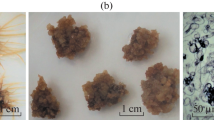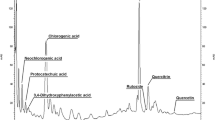Abstract
When cultivated in 6,7-V medium in suspension culture, Salvia miltiorrhiza, transformed with Agrobacterium tumefaciens C58, grew rapidly, reaching about 9.7 g l−1 dry wt after 12 days. The cell line produced tanshinones: 150 mg cryptotanshinone, 20 mg tanshinone I and 50 mg tanshinone IIA/l and phenolic acids: 530 mg rosmarinic acid and 216 mg lithospermic acid B/l. The phenolic acids were intracellular while about 1/3 of the tanshinones were extracellular. This is the first report of simultaneous production of both phenolic acids and tanshinones in a single culture system.
Similar content being viewed by others
References
Bruneton J (1995) Pharmacognosy, Phytochemistry, Medicinal Plants. London: Intercept.
Chen H, Yuan JP, Chen F, Zhang YL, Song JY (1997) Tanshinone production in Ti-transformed Salvia miltiorrhiza cell suspension cultures. J. Biotechnol. 58: 147-156.
Chen H, Chen F, Zhang YL, Song JY (1999a) Production of rosmarinic acid and lithospermic acid B in Ti transformed Salvia miltiorrhiza cell suspension cultures. Process Biochem. 34 (in press).
Chen H, Chen F, Zhang YL, Song JY (1999b) Production of lithospermic acid B and rosmarinic acid in hairy root cultures of Salvia miltiorrhiza. J. Ind. Microbiol. Biotech. 22 (in press).
Dixon RA, Paiva NL (1995) Stress-induced phenylpropanoid metabolism. Plant Cell 7: 1085-1097.
Eisenreich W, Schwarz M, Cartayrade A, Arigoni D, Zenk MH, Bacher A (1998) The deoxyxylulose phosphate pathway of terpenoid biosynthesis in plants and microorganisms. Chem Biol 5: R221-R233.
Hain R, Reif HJ, Krause E, Langebartels R, Kindl H, Vornam B, Wiese W, Schmelzer E, Schreier PH, Stoecker RH, Stenzel K (1993) Disease resistance results from foreign phytoalexin expression in a novel plant. Nature 361: 153-156.
Hu ZB, Alfermann AW (1993) Diterpenoid production in hairy root cultures of Salvia miltiorrhiza. Phytochemistry 32: 699-703.
Hutcheson SW (1998) Current concepts of active defense in plants. Annu. Rev. Phytopathol. 36: 59-90.
Maher EA, Bate NJ, Ni W, Elkind Y, Dixon RA, Lamb CJ (1994) Increased disease susceptibility of transgenic tobacco plants with suppressed levels of preformed phenylpropanoid products. Proc. Natl. Acad. Sci. USA 91: 7802-7806.
Miyasaka H, Nasu M, Yoneda K (1989) Salvia miltiorrhiza: In vitro production of crytotanshinone and ferruginol. In: Bajaj YPS, ed. Biotechnology in Agriculture and Forestry: Medicinal and Aromatic Plants II, Berlin: Springer, pp. 417-430.
Morimoto S, Goto Y, Shoyama Y (1994) Production of lithospermic acid B and rosmarinic acid in callus tissue and regenerated plantlets of Salvia miltiorrhiza. J. Nat. Prod. 57: 817-823.
Petersen M, Szabo E, Meinhard J, Karwatzki B, Gertlowski C, Kempin B, Fuß E (1995) Biosynthesis and accumulation of rosmarinic acid in suspension cultures of Coleus blumei. Plant Cell Tissue Org. Cult. 43: 89-92.
Poppy GM (1999) The raison dêtre of secondary plant chemicals? Trends in Plant Science 4: 82-83.
Shimomura K, Kitazawa T, Okamura N, Yagi A (1991) Tanshinone production in adventitious roots and regenerates of Salvia miltiorrhiza. J. Nat. Prod. 54: 1583-1587.
Taiz L, Zeiger E (1998) Plant Physiology, 2nd edn. Sunderland, Mass.: Sinauer Associates, pp. 349-350.
Veliky IA, Martin SM (1970) A fermenter for plant cell suspension cultures. Can. J. Microbiol. 16: 223-226.
Verpoorte R (1998) Exploration of nature's chemodiversity: The role of secondary metabolites as leads in drug development. Drug Discovery Today 3: 232-238.
Xu RS (1990) Dan-Shen (Salvia miltiorrhiza) — Its Biology and Applications. Beijing: Science Press (in Chinese).
Author information
Authors and Affiliations
Rights and permissions
About this article
Cite this article
Chen, H., Chen, F. Kinetics of cell growth and secondary metabolism of a high-tanshinone-producing line of the Ti transformed Salvia miltiorrhiza cells in suspension culture. Biotechnology Letters 21, 701–705 (1999). https://doi.org/10.1023/A:1005562410037
Issue Date:
DOI: https://doi.org/10.1023/A:1005562410037




